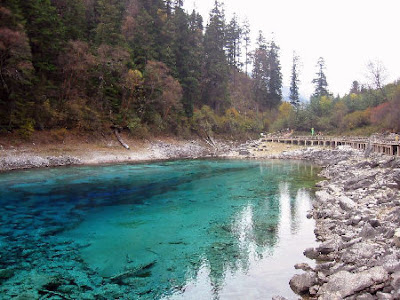Jiuzhaigou Valley (simplified Chinese: 九寨沟; traditional Chinese: 九寨溝; pinyin: Jiǔzhàigōu; literally "Valley of Nine Villages"; Tibetan: གཟི་རྩ་སྡེ་དགུ།, Wylie: gzi-rtsa sde-dgu, ZYPY: Sirza Degu) is a nature reserve and national park located in northern Sichuan Province of southwestern China.
Jiuzhaigou Valley is part of the Min Shan mountain range on the edge of the Tibetan Himalayan Plateau and stretches over 72,000 hectares. It is known for its many multi-level waterfalls, colorful lakes, and snow-capped peaks. Its elevation ranges from 2,000 m to 4,500 m.
Jiuzhaigou Valley was inscribed by UNESCO as a World Heritage Site in 1992 and a World Biosphere Reserve in 1997. It belongs to the category V (Protected Landscape) in the IUCN system of protected area categorization.
Jiuzhaigou (literally "Nine Village Valley") takes its name from the nine Tibetan villages along its length.
The remote region was inhabited by various Tibetan and Qiang peoples for centuries. Until 1975 this inaccessible area was little known. Extensive logging took place until 1979, when the Chinese government banned such activity and made the area a national park in 1982. An Administration Bureau was established and the site officially opened to tourism in 1984; layout of facilities and regulations were completed in 1987.
The site was inscribed by UNESCO as a World Heritage Site in 1992 and a World Biosphere Reserve in 1997. The tourism area is classified as a AAAAA scenic area by the China National Tourism Administration.
Jiuzhaigou Valley is part of the Min Shan mountain range on the edge of the Tibetan Himalayan Plateau and stretches over 72,000 hectares. It is known for its many multi-level waterfalls, colorful lakes, and snow-capped peaks. Its elevation ranges from 2,000 m to 4,500 m.
Jiuzhaigou Valley was inscribed by UNESCO as a World Heritage Site in 1992 and a World Biosphere Reserve in 1997. It belongs to the category V (Protected Landscape) in the IUCN system of protected area categorization.
Jiuzhaigou (literally "Nine Village Valley") takes its name from the nine Tibetan villages along its length.
The remote region was inhabited by various Tibetan and Qiang peoples for centuries. Until 1975 this inaccessible area was little known. Extensive logging took place until 1979, when the Chinese government banned such activity and made the area a national park in 1982. An Administration Bureau was established and the site officially opened to tourism in 1984; layout of facilities and regulations were completed in 1987.
The site was inscribed by UNESCO as a World Heritage Site in 1992 and a World Biosphere Reserve in 1997. The tourism area is classified as a AAAAA scenic area by the China National Tourism Administration.

















































